
Centre of Jaina Studies Newsletter: SOAS - University of London
The present day Tuḷunāḍu Jains can be divided into three groups: (1) Jains (2) Śeṭṭi-Jains and (3) Indra-s. They are all Digambaras and speak both Tuḷu and Kannada.
The Indra-Jains (also known as "Purohita-s" and "Jain-Brāhmaṇas") are hereditary priests at [Digambara] Jain temples (basadi-s). The Venerable Bhaṭṭāraka Cārukīrti Svāmi-jī of the Shravaṇabeḷgoḷa Maṭha belongs to this community. The Indra-s are functionally comparable to the Upādhye-s of northern Karnataka. Muniśrī Vidyānanda-jī, presently in Delhi, as well as the renowned Prakrit scholar, Dr. Ādinātha Neminātha Upādhye, are Upādhye-s from the Kolhapur area. A majority of the Jain community are simply called "Jains." Most of them were land-owners who lived in villages and near market places (peṭe). They cultivated the paddy-fields, and plantations of coconuts and areca (aḍike) nuts. The term "Jain" was never used by them as a surname. They shared a dozen or more surnames (e.g. Ajila, Adhikāri, Ballāḷa, Banga, Kadamba) with a nonJain Tuḷu community called the Bunts, and also followed their aḷiya-kaṭṭu, the law of matrilineal inheritance (Rao 2010: 150-5).
The "Jains" appear to have been very active in building basadi-s. The earliest Jain inscription in Tuḷunāḍu is found in Mūḍabidrī, where the date 714 CE is given for the re-consecration of the image of tīrthaṅkara Pārśvanātha at the Guru-Basadi. Here the manuscripts of holy scriptures (Dhavalā-JayadhavalāMahādhavalā) were also preserved at a later time. The guru-pīṭha known by the name Cārukīrti-Bhaṭṭāraka was established in the year 1220. The famous temple called Tribhuvana-Tilaka-Cūḍāmaṇi (Crest-jewel of the Three Worlds) was inaugurated in the year 1430, and a large maṇḍapa (assembly hall) was added to it by the Princess Bhairādevī in 1462. Mūḍabidrī occupied a strategically central place between two colossal images of Bāhubali, one erected by the Bhairava-arasu (=rājā) of Kārkaḷa in 1432, and the other by the Ajila-arasu at Veṇūru in 1604.
The Kannada word Śetti comes from Sanskrit Śreṣṭhin (a foreman of a guild, an honorable banker) and appears in Hindi as Śeṭh or Seṭhī, and also in Tamil as Cheṭṭi where it mostly applied to a tradesman. It was believed that a large number of these Tuḷunāḍu Jains (Śeṭṭi-s to be distinguished from Bunṭ-Śeṭṭi-s), over many centuries, had migrated from northern Karnataka into Tuḷunāḍu, adopting Tuḷu and (in many cases) the aḷiya-kaṭṭu, prevalent among the "Jains." Several temples at Mūḍabidrī are named after such Śeṭṭi-s: Cola Śeṭṭi gaddige maṇḍapa Guru Basadi (1538), Vikrama Śeṭṭi Basadi, Deramma Śeṭṭi Basadi, Cola Śeṭṭi Basadi, Mādāya Śetti Basadi, also Ambu Śeṭṭi Niṣidhi, Adu Śeṭṭi Niṣidhi, etc.
It is believed that the Hoysaḷa King Devarāya of Haḷebīḍu was converted from the Jaina faith to Vaiṣṇavism and took the name Viṣṇuvardhana (r. 1104-1141). This resulted in violence towards Jain merchants causing waves (over centuries) of migration of JainŚeṭṭi-s to the coastal area of Tuḷunāḍu. They settled in various places where Jain arasu-s (rājā-s), the Bhairava-s at Kārkaḷa, the Ajila-s at Veṇūru, the Cauṭas at Mūḍabidrī and the Banga-s in Belthangaḍy, sheltered them. They brought wealth and prosperity to the area, and lived side by side with the local "Jain-s," while maintaining their own trades and traditions primarily by endogamous marriage within the Śeṭṭi community. The Indra-s also married within their own group, and strictly adhered to the patrilineal inheritance (makkaḷa-kaṭṭu) like the nonJain (Vaiṣṇava-Śaiva-Smārta) brāhmaṇas.
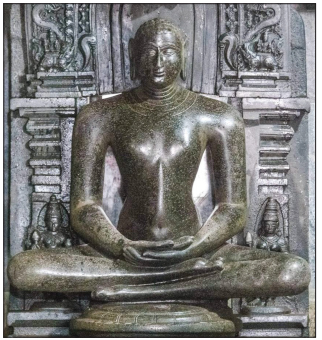
Figure 1. The image of Anantanātha Jina with termite marks. (Photo courtesy of Sheethal K. Jain)
Nellikar [=Nellikāru]
Nellikar is one such settlement, on a long cart road (now a busy bus route of 60 miles) going from Kārkaḷa to Dharmasthaḷa, via Belthangaḍy (another former Jain peṭe with three Jain temples, c. 1600). Nellikar is unique in that there are no houses of "Jains," let alone, non-Jains. It is populated only by Jain-Śeṭṭi-s and one Indra family. It is believed that (around 1700) these Śeṭṭi families arrived here from Kārkaḷa as the Bhairava royal palaces were reduced to ashes in a huge fire and the merchant class sought safety elsewhere.
The layout of the town is noteworthy. At a short distance from the main bus-road stands a large aśvatthavṛkṣa (banyan tree), that marks the start of the town. The first noteworthy building is a shed on the left side of the road. It houses the large wooden chariot (ratha), the bamboo structures and the cloth and paper decorations that will be mounted on them, as well as the long ropes to pull the chariot through the street. On each side of a wide road there are five large two-storied houses, the fronts of which might have once served as the market (peṭe). Houses end at the foot of a small hill.
Fifteen large stone steps bring one in front of a double storied Jain basadi within three brick-walls. There is no mānastambha (the customary "pillar of fame" in front of a Digambara temple), but there is an Indra-dhvaja, a tall wooden flag pole covered in copper plate, with a metal flag high on top (cf. Hegewald 2009: 193, # 405). It is believed that Indra, the king of Bhavanavāsi deva-s (gods) in Jain cosmology, raises the mānastambha in the Holy Assembly (samavasaraṇa) of a tīrthaṅkara. Hence this pillar is also known as indradhvaja (mānastambhāḥ... prāptendradhvajarūḍhikāḥ / Ādipurāṇa 22/101). Probably some four hundred years old, this temple is dedicated to the fourteenth tīrthaṅkara Anantanātha, a black stone image in cross-legged (padmāsana) posture (fig. 1). Two devī-s, Sarasvati and Padmāvati, appear at a distance on the left and right sides of the main image. During special days (such as the rathotsava) the central position between the devī-s is given to Brahma-deva, a sidewise horse-riding black stone image with two arms. In the right-arm it holds up a short sword while in the left a large fruit. It is famous for its miraculous power of hū koḍuvudu, i.e., bestowing a flower at the end of a special pūjā as a blessing in response to the prayers of devotees (see Flügel 2015).
All three sides of the temple walls are surrounded by two-storied houses, with their own wells, backyards and cow-sheds. Facing the temple, the first house on the left is called Haḷe-mane (Old House), meaning probably the ancient house. A nāgabana, "snake-forest" for a human faced snake image, under trees within a circular wall, is in front and belongs to this house. It is our ancestral home. There are only ten houses surrounding the temple. The last house called Indra-ra mane (Indras' House) facing ours on the other side of the temple, is that of the temple-priest Śrī Candayyā (=Candrarāja) Indra, whose great-grandsons now perform the pūjā at the temple as before.
Why Haḷemane?
During my college days (c. 1940) I became curious about the unusual name Haḷe-mane (Old House) of our home and casually asked my mother for an explanation. She knew she had heard something, but asked me to see Śrī Candayyā Indra (1890-1950) a contemporary of my father. What I learnt from him has not been published and deserves to be known. He asked me to come next day early morning in clean clothes to the temple and wait for his call to enter the inner sanctum (where only Indras may go).
As I arrived there properly attired, he took me to the main stone image of Śrī Anantanātha Svāmi, seated in a cross-legged position. He pointed to me the deep termite (or white ant) marks all over the forehead, mouth, the torso, the shoulders, hands and the folded legs! And he told me an extraordinary story he had heard from his elders, of what had transpired here some three hundred years ago:
Several Jain merchants (śeṭṭi-s) running away from the fires of the Kārkaḷa palaces of the Bhairava Kings, came here to settle down and found this image seated inside a huge anthill (hutta in Kannada), and the temple, then probably a small building covered by a thatched roof, in ruins! They found the town deserted except the house near the Nāgabana, known since then as Haḷe mane! The new settlers cleared the anthill, cleaned the termite/ ant-eaten image, performed the ritual of abhiṣeka (lustration) to the image on the same place and rebuilt a small shrine. Slowly the town grew and the additional images, including that of the devī-s and the yakṣa-Brahmadeva (the guardian deity of the Bāhubali image in Karkala) were installed.
Not a single inscription was found there to collaborate this narrative, but the deep termite-marks on the image validate the above account. (Figure 1)
In all no more than twenty houses, the temple (basadi) is the heart of the town, where young and old (mostly males) gather daily for morning darśana (vision) and the evening abhiṣeka (lustration) with water, milk and sandalwood paste of the main image, followed by ārati (offering of lamps, with camphor) to the beating of drums and sound of bells.
The ritual of abhiṣeka is an enactment of the first bathing, on the mount Meru, of the baby tīrthaṅkara (to be) soon after his birth (janma), by Indra, the King of the Saudharma heaven. In ancient times, it was probably the simple daily prakṣālana (washing with water) of a tīrthaṅkara image. It might have developed into an elaborate daily "lustration" ritual (with water, milk, sandalwood paste, flowers, etc.), popularized by the 9th-century ācārya Jinasena's Ādipurāṇa, where the janmābhiṣeka of the first tīrthaṅkara Ādinātha by the god Indra is described in as many as 219 śloka-s, as in the following:
śuddhāmbusnapane niṣṭhāṃ gate gandhāmbubhih śubhaiḥ/
tato'bhiṣektum īśānaṃ Śatayajvā pracakrame//
Ādipurāṇa, parva 13, 185.
When the bathing with pure water was over, Indra (=śatayajvā) commenced lustering the Lord (Jina) with the auspicious fragrant waters (mixed with sandalwood paste).[1]
The title Indra:
At a later time, the temple priest performing this janmābhiṣeka would assume the title "Indra," reciting the following verse:
śrīman Mandaramastake śucijalair dhautaiḥ
sadarbhākṣataiḥ/
pīṭhe muktivaraṃ nidhāya racitaṃ tvat
pādapadmasrajaḥ//
Indro'haṃ nija-bhūṣaṇārtham amalam
yajñopavītaṃ dadhe,
mudrā-kaṅkaṇa-śekharāṇy api tathā
janmābhiṣekotsave//
Jain Pūjāpāṭha-sangrahaḥ/[2]
On the peak of the holy Mandara platform [of the Mount Meru], cleaned with pure water, darbha grass and rice grains, I place the Lord of Emancipation (the Jina)...
I am Indra, for my ornamentation I wear this sacred thread for the worship (yajña), the seal ring, bracelet, crown and so forth, at the lustration ceremony of his birth.
The Jains in Tuḷunadu may offer similar lustration to a portable image of a Jina placed in the outer hall of the temple, but they do not enter the inner shrine. It is well known that the Digambaras in the North have no temple-priests, nor sacred thread. A layman and his wife may perform this ritual, wearing a crown, on special occasions, calling themselves Indra and Indrāṇī for the duration of this ritual.
The Indras of the Tulunādu, however, appear to have received (from some unknown authority) the honorific name Indra as their permanent designation, probably to distinguish them from non-Jain brāhmaṇa priests, and to officiate daily as hereditary priests of Jain temples.
Rathotsava (The Chariot Festival)
The high point of the temple ritual is the annual rathotsava (Chariot festival of seven days) beginning on the Yugādi day, the first day of a New Year of the Śālivāhana Śaka era observed in South India (beginning in 78 CE). I have an elaborate invitation on a long and gaudy paper (śrīmukha patrikā) dated, 8 March (Friday) thru 14 March (Thursday), 2016. It describes the daily ritual activities (dhārmika-vidhi) for this period in Kannada. The invitation issued for the last year (March 2017) rathotsava is however quite simple. The following is a translation of the patrikā for the year 2016.
Śukravāra, Friday, 3/08/2016, Yugādi day. [Śrī Mahāvīra Śaka 2542] Durmukha nāma saṃvatsara, Yugādi pāḍya 1.
Early morning, after the ārati, hundreds of Jains from the surrounding area gather and pull out the four-wheeled wooden chariot from its shed and bring it to the steps of the temple. It has a tall platform, reached by a tenstep ladder. Several decorated wooden boards are raised around it, with colorful paper flags above, mounted high on bamboo rings. It thus becomes a holy shrine for the main rituals on Wednesday the 13th, to be performed in the presence of Svasti Śrī Bhaṭṭāraka Lalitakīrti Svāmī-jī, Śrī Jaina Maṭha, Kārkaḷa. 6:45 a.m. Indra-pratiṣṭhe: Invoking god Indra at the temple door. 7:45 a.m. in Meṣa-lagna, Toraṇa-muhūrta: placing a new flag made of tall pieces of wood in the shape of an "A," with fresh mango leaves tied around. Vimāna śuddhi: purification of the ratha by chanting of mantras. Pañcāmṛta-abhiṣeka: lustration of the main image with five ambrosias: water (jala), milk (kṣīra), curds (dadhi), sandalwood-paste (gandha) and a shower of flowers (puṣpa). Yakṣa-pratiṣṭhā and pūrvābhimukha-vidhāna: Temple dignitaries and visiting Indras gather to see the horse-riding stone image of yakṣa Brahmadeva (fig. 2), being transferred from its high seat near the massive stone pillar in the corner, to the highly decorated area, facing East, in front of the image of tīrthaṅkara Anantanātha, between the images of the devī-s Sarasvatī and Padmāvatī.
2:00 p.m. Nāndī-Maṅgala-vidhāna: Chanting of the pañca-namaskāra-mantra for happiness and fortune of all. In the evening śrī-bali-vidhāna: Offering of fruits and flowers on a short stone pillar at the entrance of the temple door (probably to ward off evil spirits).
At night, after the daily abhiṣeka and ārati, vasantakaṭṭe-pūje: A portable image (utsava-mūrti) of a tīrthaṅkara is carried in a decorated palanquin by priests around the outer wall of the basadi, receiving flowers from householders, and is placed on a decorated high seat called vasanta-kaṭṭe (spring-platform), under a campaka (sampige in Kannada) flower tree. Music is played, fireworks follow and the palanquin returns to the temple. Finally, there is Mahā ṃaṅgaḷārati (the grand ārati) after which the activities of the day are over. (Services for the day were performed in the presence of Svasti Śrī Bhaṭṭāraka Cārukīrti Svāmī-jī, Śrī Jaina Maṭha, Mūḍabidre).
Śanivāra, Saturday, 3/09/16:
8:00 a.m. Daily morning abhiṣeka. 11:25 At Mithuna-lagna, Śrī Kṣetrapālaārādhanā: propitiation of the guardian yakṣa who has a small shrine on top of a stone pillar outside, within the temple wall. 12:25 At Abhijit-muhūrta, Śrī Nāgadeva pūjā: Under the Kṣetrapāla pillar there are several stone images of hooded snakes. These are protectors of the basadi. A worship is performed asking for their continued protection. 12:45 Vāstu-pūjā-vidhāna: purifying the House (probably the Chamber on the ratha). Mangalasūtra-bandhana: Tying the auspicious thread to the wrists of those who have commissioned performance of yantra-pūjā-s. Navagraha Mahāśānti pūjā: Worship commissioned by a family for pacification of the nine planets: Sun, Moon, Jupiter, Venus, Saturn, Mars, Mercury, Rāhu and Ketu. Grāma-bali (offering worship to the village.) Probably offerings of coconuts to the village goddesses at the Aśvattha (banyan) tree at the entrance to the village. At night: The daily abhiṣeka and ārati, followed by the vasanta-kaṭṭe pūjā.
Ravivāra, Sunday, 3/10/16:
8:00 a.m. The daily abhiṣeka on the ground floor, is followed by the abhiṣeka upstairs to the image of Śrī Candranātha Svāmi. Performance (ārādhanā) of the Vajra-pañjara (Diamond Cage) a copper plate yantra, inscribed with holy diagrams for health and longevity. 4:15 p.m. In Siṃha-lagna, Śrī Sarasvati Devī pratiṣṭhe: A "re-consecration" ceremony for the image of Sarasvatidevī. (Probably this is not a public function.) At night: Vasanta-kaṭṭe pūje. (Services for today were performed in the presence of Svasti Śrī Bhaṭṭāraka Lakṣmisena Svāmī-jī, Śrī Jaina Maṭha, Simhanagadde, Narasimharājapura).
Somavāra, Monday, 3/11/16:
8:00 a.m. Śrī Caturviṃśati-tīrthaṅkara-ārādhane: Worship of the 24 tīrthaṅkaras. 12:00. p.m. Upstairs abhiṣeka to the image of tīrthaṅkara Śrī Candranātha Svāmi. 6:15 p.m. In Kanyā-lagna, Śrī Padmāvati-devī pratiṣṭhe: A "re-consecration" ceremony for the image of Śrī Padmāvati-devī. At night: Vasanta-kaṭṭe pūjā. (Services for today were performed in the presence of Svasti Śrī Bhaṭṭāraka Lalitakīrti Svāmī-jī, Śrī Jaina Maṭha, Kārkaḷa.)
Maṅgaḷavāra, Tuesday, 3/12/16:
8:00 a.m. After the daily abhiṣeka and ārati there follows an elaborate ritual of the pratiṣṭhā ("re-consecration") of the mūlanāyaka image of Śrī Anantanātha Svāmi. In the daily [janma] abhiṣeka, the festival is of bathing the new born baby (tīrthaṅkara to be). At the time of the rathotsava, there is going to be a celebration of the same person's attainment of Omniscience (kevalajñāna) and thus becoming a tīrthaṅkara. He will then appear in the holy assembly called samavasaraṇa. This transition is implied in the pratiṣṭhā (or symbolically a re-consecration) by the rituals of Mantra-nyāsa and Nayanonmīlana, given below. These are performed by a senior Indra, a Master (ācārya) of pratiṣṭhā. 12:05 Aṣṭa-dikṣu-dhāma samprokṣaṇa: purification of eight directions by sprinkling holy sandalwood-paste water.
Gandha(Gaṇadhara?)-yantra-ārādhanā: Worship of a yantra with the names of twelve canonical scriptures inscribed, as taught by the immediate disciples (gaṇadhara-s) of the tīrthaṅkara Mahāvīra. Mantra-nyāsa: writing (with sandalwood paste) of the holy mantras on the image of Śrī Anantanātha Svāmi. Saṃskāra-mālā-ārohaṇa: placing of a consecrated garland on the image. In Mithuna-lagna the pratiṣṭhā of the image by nayanonmīlana ("opening of the eyes") [by a small stick with sandalwood paste]. This is followed by abhiṣeka with 108 pitchers of water. 6:15. p.m. in Kanyā-lagna, a ritual of the pratiṣṭhā ("reconsecration") of the image of Śrī Yakṣa Brahmadeva. Daily abhiṣeka and ārati. Aśvattha-kaṭṭe-pūjā: Offering lamp-worship at the platform under the Banyan tree at the start of the town. While returning, Aramane-kaṭṭe-pūjā, ārati on a decorated Platform in front of the "palace," the ancestral home of Paṭṭaṇa-śetty, the City Mayor, followed by Vasanta-kaṭṭe pūjā, etc. (Services for today were performed in the presence of Svasti Śrī Bhatṭāraka Devendrakīrti Svāmī-jī, Śrī Jaina Maṭha, Hombuja = Humca).
Budhavāra, Wednesday, 3/13/16:
The samavasaraṇa where the tīrthaṅkara sits in his omniscient glory, is decorated (by gods) with eight auspicious objects (lotus, golden jar filled with water, etc.). Yakṣa-s stand with arms raised high, holding the dharma-cakra (The Wheel of Law) on their heads, the Ādipurāṇa, p. xxii, v. 292, says:
tāṃ pīṭhikām alaṃcakrur aṣṭamaṅgalasaṃpadaḥ/
dharmacakrāṇi coḍhāni prāṃśubhir
yakṣamūrddhabhiḥ//
On this day, the Festival of the Chariot (ratha) begins. This is the day memorable for the procession of two yakṣa-s, from the temple to the ratha. One is Brahmadeva, whose horse-riding image is familiar to the public. There is another, called Sarvāhṇa yakṣa, whose image is seen in public only on this occasion. This is because, this four armed yakṣa performs a distinguished function of carrying a dharma-cakra in his raised two back-hands, while folding his two front hands in greeting (namaskāra)! This yakṣa is also known as Gomedha (Sarvāhaṇa) yakṣa of tīrthaṅkara Nemi, but without an image (cf. Hegewald 2009: 671). It is believed that this yakṣa heralds the arrival of the tīrthaṅkara, who is going (vihāra) from place to place. 7:00 a.m. The abhiṣeka of nine pitchers to the images of Śrī Anantanātha Svāmi and Śrī Brahmadeva. This is followed by Lakṣa-hūvina-pūje (worship with a lakh flowers), apparently performed by laymen and women. Śrī Bali-vidhāna: possibly, offering fruits and flowers at the Banyan Tree-platform, pacifying the village divinities.
Ratha-samprokṣaṇe: sprinkling of holy water (collected from the abhiṣeka) on the ratha, both inside and outside. By 11:00a.m. a crowd has gathered around the ratha, waiting for the arrival of the yakṣa-s. Then in the Abhijit muhūrta, the dignitaries of the town and the assembled Indras, pray to the yakṣa Brahmadeva for permission to begin the rathotsava.
Śrī Sarvāhṇa-yakṣa-vihāra:
This is the time for bringing out a portable bronze image, called utsava-mūrti, of the yakṣa Sarvāhṇa, holding the dharma-cakra (fig. 3). It is profusely decorated with ornaments and flower garlands. It is carried on his head by an Indra, dressed in silken colored dhoti, but bare-chested, with strings of beads and gold necklaces, hanging from his neck. He comes out of the temple and a procession begins, within the temple walls, keeping the temple to the right hand, with music of nāgasvaram (Indian pipe) and the beating of drums, followed by the crowd, all barefoot in scorching heat.
The procession returns from the left side and the Indra stands in front of the temple gates, facing the ratha below. The Indras on one side and trustees on the other, greet him and invoke the yakṣa Sarvāhṇa to appear and join the ratha festival. At the moment of the ārati, the Indra carrying the yakṣa image raises his arms high (as if imitating the yakṣa image holding the dharma-cakra) and exhibits a slight animation. It is believed that he thus becomes a pātri (a role player) of the yakṣa (fig. 4). The yakṣa image slowly descends the temple steps and meets the large crowd waiting near the decorated ratha. He walks on both sides of the street giving the crowd a vision (darśana) and stands by the ladder of the ratha, awaiting the arrival of the tīrthaṅkara-image (fig. 5).
Śrī Anantanātha Svāmi-vihāra by an Indra, a pātri of Śrī Brahmadeva yakṣa:
Another Indra then comes out of the temple, carrying on his head a portable bronze image (utsava-mūrti) of the standing tīrthaṅkara Anantanātha Svāmi (fig. 6). He is said to be a pātri (role player) of the yakṣa Brahmadeva. He goes around the inner walls of the temple, and descends the temple steps to the loud greetings of jayajaya (victory, victory) from the gathered devotees. The two Indras, one carrying the image of yakṣa Sarvāhṇa and the other carrying the image of tīrthaṅkara Anantanātha Svāmi, meet face to face. This is said to be a magical moment of the ritual, attended by loud chanting of hymns, welcoming the arrival of the tīrthaṅkara to the newly erected gandha-kuṭi (a fragrant hut) for him on the ratha.
It would appear, from the way the dharma-cakra carrying image leads the tīrthaṅkara image to the "chariot-shrine," that the ratha ceremony is, in essence, an enactment of the vihāra of the tīrthaṅkara from one place to another. The images are then carried above, climbing the ladder and placed ceremonially on the high seat prepared for the tīrthaṅkara, and a lower side seat for the Sarvāhṇa yakṣa. Waving of the lamps (ārati) and shower of flowers (puṣpavṛṣṭi) will follow and the crowd disperses having witnessed an enactment of a vision (darśana) of the tīrthaṅkara on his arrival at their humble abode!
Both images are returned to the temple for the evening ārati. Public meetings are held for discourses by learned speakers and the chanting of bhajana-s by women. The night ends with artists from surrounding areas performing dance-dramas called yakṣa-gāna on the Jain themes like Bāhubali's renunciation after defeating his brother Bharata, the two sons of the first tīrthaṅkara Ādinātha. (Services for today were performed in the presence of Svasti Śrī Bhaṭṭāraka Lalitakīrti Svāmī-jī, Śrī Jaina Maṭha, Kārkaḷa.)

Figure 3. The image of Sarvāhṇa Yakṣa carrying dharmacakra. (Photo courtesy of Bhatṭāraka Cārukīrtiji, Jain Maṭha, Mūḍabidrī)
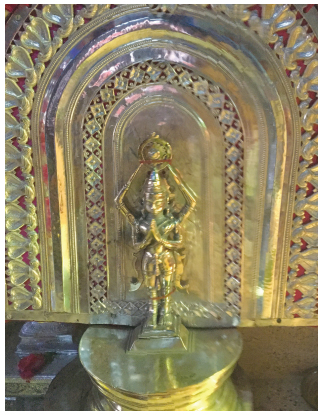
Figure 4. Indra carrying the image of Sarvāhṇa yakṣa descends the steps to the decorated ratha (chariot).(Photo: Sheethal Nisarga Hosmar)
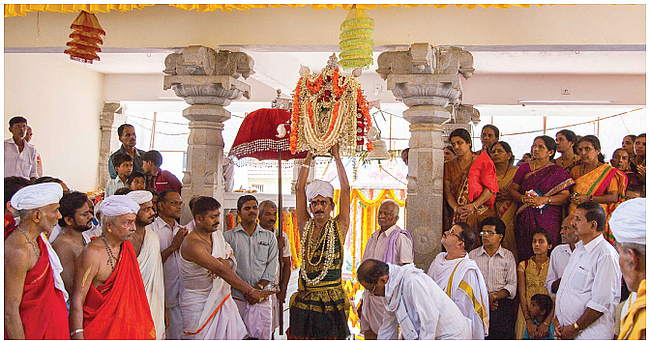
Figure 5. Indra carrying the image of Sarvāhṇa yakṣa awaits the arrival of the Indra carrying the image of a standing Jina. (Photo: Sheethal Nisarga Hosmar)
Guruvāra, Thursday 4/14/2016 7:00 a.m. avabhṛt[h]a-snāna ("bathing or ablution after a sacrificial ceremony." Monier-Williams Dictionary) The daily abhiṣeka and ārati. Guru-pūjā: The trustees honor with shawls and dakṣiṇā (gifts) of silver coins, primarily the pratiṣṭhācārya Śrī Nāgakumāra Indra from Karkala, who presided over the ritual activities. He is followed by the pratiṣṭhā upādhyāya Śrī Prasanna Indra of the Nellikar basadi, his family members, and guest Indras in attendance. Kaṅkaṇa-visarjana: Untying the red string on the wrist (that was tied on the first day). This indicates that the Indras and the trustees have accomplished their task and are now free from certain restrictions accepted during the rathotsava period. Dhvaja-avarohaṇa: Bringing the A-shaped wooden flag (dhvaja) from the temple-door step to the ratha. Kuṃkumotsava: Celebrating the conclusion by sprinkling water mixed with vermilion on each other, okuḷi in Kannada, followed by the removal of flags and other decorations of the ratha. At the end, the ratha is taken back to its shed.
Have the Indra-s always been Jains?
The janmābhiṣeka is an exclusively Jain ritual, and the participation of the "Jain" yakṣa-s in it is supported by the Purāṇa-s. In the Śrīmukha-patrikā, there appear non-Jain elements in other rituals, notably, the Navagrahamahāśānti-pūjā, the Vajrapañjara-ārādhanā, the Śrī Bali-vidhāna, and most importantly, the avabhṛtasnāna and the distribution of dakṣiṇā-s to the Indra-s. Have these priests (Jain-brāhmaṇa-s) always been Jains, as they are believed to be? A study of some literary and inscriptional sources (given here in their chronological order) shows that, around 10th century, certain South Indian Vedic brāhmaṇa-s of high standing and learning, became converts to the Jaina faith, a few eminent poets (kavi-s) producing classical works in Apabhraṃśa or Kannada, while some becoming priests in Jain temples.
Two poets of a South Indian brāhmaṇa family accepting the Jain faith.
(1)Mahākavi Puṣpadanta (=Pupphayaṃta): He is the author of the Apabhraṃśa Mahāpurāṇu (completed in Śaka 887 = 965 CE), during the rule of the Rashtrakuta Krishna III, at Mānyakheḍa=Malkhed village, (destroyed in 970 CE) now in Maharashtra. In his praśasti of the Mahāpurāṇu, Puṣpadanta says:
Śivabhattāiṃ mi Jiṇasaṇṇāseṃ ve vi mayāiṃ
duriyaṇiṇṇāseṃ/
baṃbhaṇāiṃ Kāsava-risigottāiṃ
guruvayaṇāmiya-pūriyasottāiṃ//
Muddhādevī-Kesavanāmāiṃ mahu piyarāiṃ
hoṃtu suhadhāmaiṃ//
My parents, devotees of Śiva, died in the manner of the recluses of the Jina (i.e. by performing sallekhanā=fast unto death) as their ears were filled with the ambrosia of the [Jain] words. They were brāhmaṇas of the gotra of the sage Kāśyapa, my mother Mugdhādevī and my father Keśava. May they attain happy abodes.
At the end of the Uttarapurāṇa:
Maṇṇakheḍapuravare ṇivasaṃte maṇe Arahaṃtu
deu jhāyaṃte/...
Pupphayaṃtakaiṇā dhuyapaṃkeṃ jai
Ahimāṇameru-ṇāmake/
kayau kavvu bhattie paramattheṃ Jiṇapaya
paṃkaya-mauliya-hattheṃ/
(Harivaṃśapurāṇu, Introduction, p. 2, 1941).
The Poet Puṣpadanta, known by the name 'Abhimāna-meru', living in the Mānyakheṭa City, having cleaned his mind of sins by contemplating in his mind on the Divine (deva) Arahanta (One worthy of honor, i.e. the Jina), and having joined his hands in worship of his lotus-feet, has created this kāvya [Mahāpurāṇa] with pure devotion.
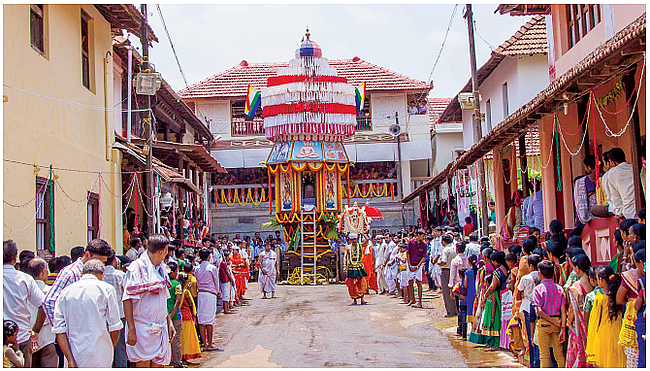
Figure 6. Indra carrying the image of a standing Jina around the temple on his way to the ratha (chariot). (Photo courtesy of Shailendra)
(2)The tenth century "Kannada ādikavi" Pampa.
Pampa is the author of the Ādipurāṇa and Vikramārjunavijaya (= Pampa Bhārata), the latter completed in 941 CE during the reign of the Cālukya Prince Arikesari II at Vengi (in Andhra). In the Pampabhāratam (Ch. 14, 48) Pampa, who had the epithet of kavitā-guṇārṇava, says:
jātimoḷellam uttamada jātiya Viprakulage
naṃbalemāto
Jinendradharma-me valaṃ dore
dharmadaveṃdu nambi ta-j-jātiyan uttarottarama
māḍi negaliḍidan intarātma-vi- khyātiyan ātanāda
magaṃ negaḷdaṃ Kavitā-guṇārṇavam// 48//
Of all the varṇa-s Brahmanism is the best. But Jainism is king among religions. For a Brahmin who desires to improve his caste, Jainism is ideal choice. With this belief, Abhirāmadevarāya (= Bhīmapayya) embraced Jainism.
Inscriptional record of a temple priest "JinaBrāhmaṇa":
At Amarapuram (in Karnataka) in the year 1278 CE came into being a significant temple dedicated to god Prasanna Pārśvadeva, which was named Brahma Jinālaya. Bālendu Maladhārideva, Kundakundānvaya... was responsible for the creation of this holy structure... Malliseṭṭi... made a gift... for the temple. The income derived from the gift was to be used for reconstructing the Jaina temple with stone from the foundation to the pinnacle with the mahāmaṇḍapa, bhadramaṇḍapa, Lakshmīmaṇdapa, gopura, mānastambha... the gift was received by the temple priest Chellapiḷḷe who hailed from Bhuvalokanāthanallūr in the southern Pāṇḍya country. He was a Jina Brāhmaṇa of Yajurveda, Aitareya śākhā, Vasiṣṭha gotra and the pravara Kauṇḍinya-Maitrāvaruṇa-Vasiṣṭha... at this time the region was under the... NoḷambaPallava chief Irungoḷa II who was a patron and follower of the Jaina religion" (South Indian Epigraphy, 1917, Appendix C, No. 40-42, in Desai 1957: 158).
I would like to suggest the possibility of the Tuḷunāḍu Jain-brāhmaṇas being successors to a similar Vedic heritage, prior to their conversion to Jainism. While following the Ādipurāṇa as their primary scripture, they may have adopted non-Jain rituals like the Navagrahaśānti-vidhāna, popular among the laity. In doing this no Vedic divinity was invoked. Instead, the graha-s (planets), like Saturn (śani) were joined with a tīrthaṅkara and a Jain yakṣa, as in the following mantra:[3]
Oṃ namo arhate bhagavate śrīmate Munisuvrata tīrthakarāya Varuṇa yakṣa Bahurūpiṇī yakṣī sahitāya Śani mahāgrahadevāya... nakṣtra-jātasya... nāmadheyasya sarva śāntiṃ kuru kuru svāhā//
The Indras of Nellikar are to be commended for their dedication in carrying out the centuries old annual Jain rathotsava in a traditional manner.
Padmanabh S. Jaini is Professor Emeritus of Buddhist Studies at the Department of South and Southeast Asian Studies, University of California, Berkeley.
References
Ādipurāṇa of Jinasena. 9th C. In: Ācārya Jinasena-Kṛta Ādipurāṇa. Bhāga I-II. Hindī Anuvāda, Prastāvanā Tathā Pariśiṣṭa Sahita. Sampādana - Anuvāda: Pannālāla Jaina. Kāśī: Bhāratiya Jñānapīṭha, 1950 / 1963.
Chabda, K. (Ed.). Jaina Pūjāpāṭha-saṃgrahaḥ. Calcutta, no date. Desai, Pandurang Bhimarao. Jainism in South India and Some Jaina Epigraphs. Sholapur: Jaina Samskriti Samarshak Sangh, 1957.
Flügel, Peter: "Digambara Jaina Divination Rituals in Coastal Karṇāṭaka." Jaina Tantra. 16th Jain Studies Workshop, Centre of Jaina Studies, SOAS, 20.3. 2015 (PPP).
Harivaṃśapurāṇu. Ed. P. L. Vaidya. Vol. III. Pariccheda-s 82 to 92. Poona, 1941.
Hegewald, Julia A. B. Jaina Temple Architecture: The Development of a Distinct Language in Space and Ritual. Monographien zur indischen Archäologie. Berlin: G. H. Verlag, 2009 (Kunst und Philologie 19).
Mandira-Vedī-pratiṣṭhā-Kalaśārohaṇa-vidhi, Varanasi, 1962.
Pampabhāratam. Ed. K. V. Puttappa (Ch. 14, 48) emba Vikramārjunavijayam. Mysore: Mysore University, 2004.
Rao, Surendra B. "The Jaina Connection." Bunts in History and Culture. Mangalore: World Bunts' Foundation Trust, 2010, pp. 150-155.
Śrīmukha Patrikā: March 08 - March 14, 2016. Nellikar Basadi. Karnataka.
Triṣaṣṭiśalākāpuruṣacaritra of Ācārya Śrī Hemacandra. Translated by Helen M. Johnson: The Lives of Sixty-three Illustrious Persons. Vol. I. Baroda: Oriental Institute, 1931 (Gaekwad's Oriental Series 51).
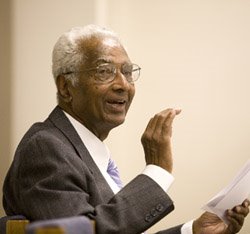 Padmanabh S. Jaini
Padmanabh S. Jaini